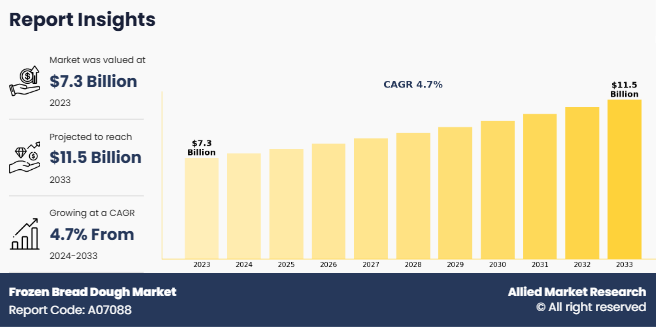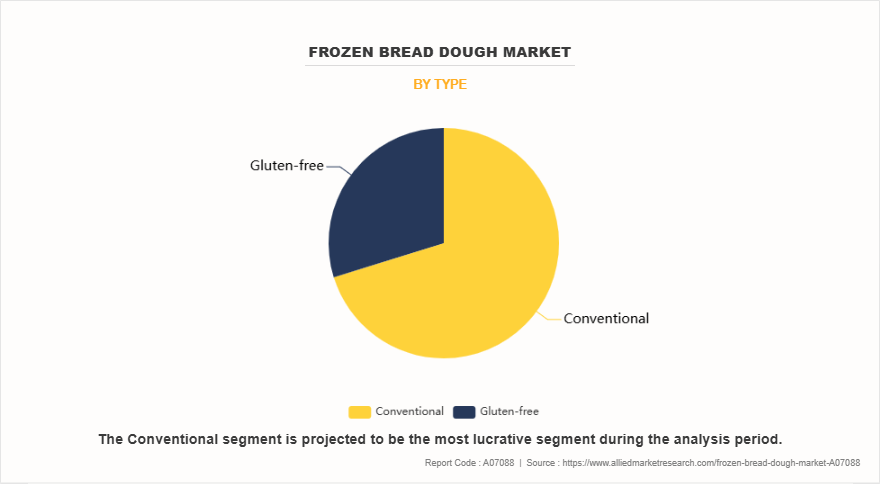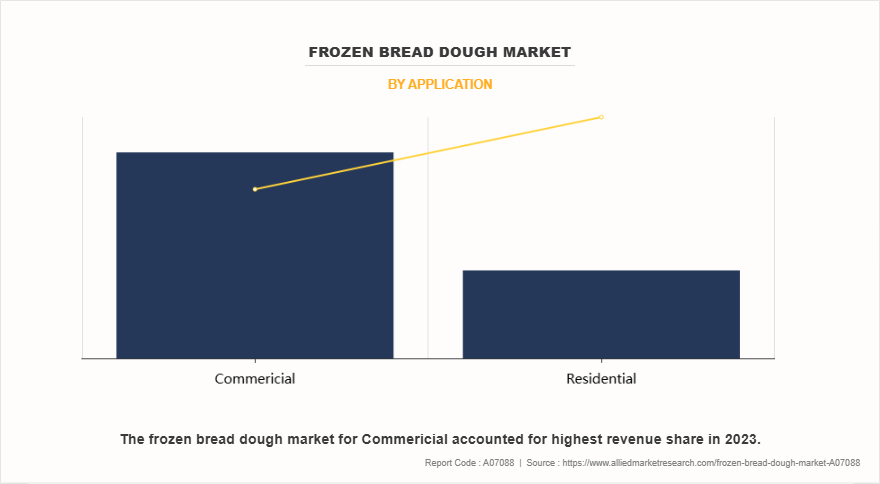Frozen Bread Dough Market Research, 2033
The frozen bread dough market was valued at $7,310.00 million in 2023 and is estimated to reach $11,530.40 million by 2033, exhibiting a CAGR of 4.7% from 2024 to 2033. Frozen bread dough is a pre-made dough that is frozen to preserve freshness and extend shelf life, allowing consumers or foodservice operators to bake bread products at their convenience. It offers consistency, convenience, and time-saving benefits, making it popular in both residential and commercial applications. The growth in the food service industry is significantly driving the frozen bread dough market demand as restaurants, bakeries, hotels, and catering services seek efficiency and consistency in their operations. With a growing trend towards fast-casual dining, quick-service restaurants (QSRs), and expanding bakery chains, the need for ready-to-bake products such as frozen bread dough has increased. For instance, in the U.S., according to National Restaurant Association, the restaurant industry was valued at over $900,000 million in 2023, with a substantial portion of this market relying on frozen dough for bread and baked goods owing to its convenience and reduced labor costs. This trend is further supported by rise in demand for high-quality, fresh bread products that can be easily integrated into large-scale food service operations without the need for extensive preparation. As the food service sector continues to expand, particularly in urban areas, and with rise in delivery services, the use of frozen bread dough remains a cost-effective solution for meeting customer demand efficiently.

Market Dynamics
Rise in demand for ready-to-bake products significantly drives the frozen bread dough industry. This shift is inspired by consumers' increasing preference for convenience, quick meal preparation, and freshly baked goods at home without the complexity of weighing and mixing all ingredients. According to data from the U.S. Department of Agriculture (USDA), per capita consumption of wheat flour, which includes bakery products, exceeded 130 pounds annually, showcasing a strong base for growth in related sectors. In addition, rise in home baking and artisan-style bread during recent years has also expanded the market for semi-prepared bakery solutions such as cakes and pastries, including frozen bread dough. Similarly, the government agency, Eurostat indicates a consistent upward trend in Europe’s bakery sector, where baked goods represent over 20% of the total output of food manufacturing. Thus, demand for home baking is further propelled by advancements in cold-chain logistics and availability of specialty frozen dough options that cater to diverse taste preferences.
Globalization and evolving culinary trends are increasing the growth of the frozen bread dough industry by broadening consumers’ tastes and preferences. The increasing exposure to international cuisines has increased the demand for diverse baked goods, such as European-style breads, flatbreads, and specialty loaves, which are now in great demand. According to the Food and Agriculture Organization (FAO), global wheat production consistently exceeded 750 million metric tons annually in 2023, supporting a growing bakery sector that benefits from a steady supply of raw materials. The European Union, a leader in bakery production, exports a significant share of its baked goods globally, reflecting strong international trade driven by culinary interest. In the U.S., the baking industry, valued at over $50,000 million annually by the American Bakers Association, is witnessing growth in artisan and specialty bread consumption owing to multicultural influences. These trends are complemented by the convenience of frozen bread dough, which allows consumers and food service operators to access a variety of high-quality baked items with minimal preparation, catering to expanding tastes and simplifying global culinary integration.
The growing interest in home baking and culinary activities as hobby, is creating substantial opportunities for the frozen bread dough market. Consumers seeking the satisfaction of fresh, homemade baked goods without the time and expertise required for baking from scratch are increasingly turning to ready-to-bake solutions. According to the USDA, household spending on bakery products remains strong, indicating a growing demand for baked goods for home consumption. The National Association of Home Bakers highlights that during periods of increased home-based activities, such as holidays or stay-at-home trends, interest in baking rises, driving demand for simple, high-quality ingredients like frozen dough. In Europe, bakery products are staples, with baked goods accounting for a significant share of food expenditure, as per the Eurostat in 2023. The convenience offered by frozen bread dough o, enabling home bakers to achieve professional-quality results with minimal preparation, caters to both seasoned enthusiasts and beginners. The frozen bread dough market growth is attributed to its combination of ease, consistent quality, and time savings, making it an appealing option for individuals looking to enjoy baking without the complexities of traditional dough preparation. The frozen bread dough market share is experiencing a huge growth in the global marketplaces owing to its high utilization among foodservices globally.
However, the perception of freshness presents a significant restraint to the frozen bread dough market size, as many consumers compare freshly made bread with higher quality, superior taste, and better texture. While frozen dough offers convenience, some people may perceive it as less fresh or inferior to bread baked from scratch or purchased fresh from a bakery. This perception can deter consumers from choosing frozen dough, especially those who prioritize the sensory experience of fresh bread. Furthermore, artisanal bakeries and home bakers may be more inclined to make dough from scratch to ensure authenticity and control over ingredients. This influence toward fresh products can limit the widespread adoption of frozen bread dough, particularly in markets where traditional bread-making methods are highly valued. As a result, the perceived lack of freshness is expected to hinder the frozen bread dough marketmarket growth, particularly if consumers view frozen dough as inferior in quality compared to freshly baked alternatives.
Segmental Overview
The frozen bread dough market size is segmented on the basis of type, application, and region. By type, the market is divided into conventional and gluten-free. By application, the frozen bread dough market is bifurcated into residential and commercial. By region, the market is divided into North America, Europe, Asia-Pacific, and LAMEA.
By Type

By type, the conventional segment dominated the market in 2023 and is anticipated to maintain its dominance during the forecast period. The conventional frozen bread dough market is driven by rise in demand for convenient baking solutions in retail and foodservice sectors. Key trends in the market include a preference for clean-label products with minimal additives and rise in consumer interest in artisanal bread styles. Growth factors for conventional frozen bread dough include urbanization, busy lifestyles, and the growing penetration of quick-service restaurants and bakeries that rely on frozen dough for operational efficiency.
By Application

By application, the commercial segment holds a dominant position in the frozen bread dough market share in 2023 and is anticipated to maintain its dominance during the forecast period. The commercial application of frozen bread dough is growing owing to the foodservice industry's need for cost[1]effective and time-efficient solutions. Key trends for the commercial segment include a shift toward premium and artisanal bread offerings, as consumers increasingly seek high-quality products in quick-service restaurants, cafes, and bakeries. Growth of the commercial segment is increased by urbanization, rise in disposable incomes, and increase of dine-out cultures.
By Region

By region, Europe dominated the market in 2023 Â and is anticipated to maintain its dominance during the frozen bread dough market forecast period. The Europe frozen bread dough market benefits from a strong tradition of bakery consumption and rise in demand for convenience products. Countries such as Germany, France, and Italy dominate the market owing to their high bread consumption per capita. The market is also driven by consumer preference for artisanal and specialty breads, aligning with trends toward clean-label and minimally processed foods.
Competition Analysis
The major players operating in the market focus on key market strategies, such as mergers, product launches, acquisitions, collaborations, and partnerships. They have also been focusing on strengthening their market reach to maintain their reputation in the ever-competitive market. Some of the key players in the global frozen bread dough market includes J&J Snack Foods Corp., Aryazta AG, Associated British Foods PLC, General Mills Inc., George Weston Limited, Bridgford Foods, Dawn Food Products Inc., Campbell Soup Company, The Cerelia Group, Grupo Bimbo, EDNA international gmbh, Rhodes, groupe le duff, Lantmännen UNIBAKE, Jiangxi Xinwanlai Food Co., Ltd., FLOWER FOODS INC., NamChow, EUROPASTRY S.A., Gonnella, La Rose Noire, Guttenplan’s, Rich Products Corp., and Aokun Food.
Recent Developments in the Market
In August 2024, Spanish bakery, Europastry acquired Dutch frozen bakery company, De Groot Edelgebak, continuing its expansion in Europe. This acquisition strengthens Europastry's presence in the food service market.
In February 2024, Europastry acquired 94.7% stake in German company, DeWiBack, which specializes in frozen doughs for the hospitality and catering industry.
In June 2022, Lantmännen completed the acquisition of the Finnish milling and bakery group Myllyn Paras. The acquisition is a key step in strengthening Lantmännen's position in Finland and broadening its sustainable grain-based product offering to better meet the growing demand for products with local origin in the Nordics.
In March 2021, ARYZTA AG signed a definitive agreement to sell 100% of the equity and assets of its North American business in the U.S. and Canada to an affiliate of Lindsay Goldberg LLC for a total enterprise value of $850 million in cash.
Key Benefits For Stakeholders
- This report provides a quantitative analysis of the market segments, current trends, estimations, and dynamics of the frozen bread dough market analysis from 2023 to 2033 to identify the prevailing frozen bread dough market opportunities.
- The market research is offered along with information related to key drivers, restraints, and opportunities.
- Porter's five forces analysis highlights the potency of buyers and suppliers to enable stakeholders make profit-oriented business decisions and strengthen their supplier-buyer network.
- In-depth analysis of the frozen bread dough market segmentation assists to determine the prevailing market opportunities.
- Major countries in each region are mapped according to their revenue contribution to the global market.
- Market player positioning facilitates benchmarking and provides a clear understanding of the present position of the market players.
- The report includes the analysis of the regional as well as global frozen bread dough market trends, key players, market segments, application areas, and market growth strategies.
Frozen Bread Dough Market Report Highlights
| Aspects | Details |
| Market Size By 2033 | USD 11.5 billion |
| Growth Rate | CAGR of 4.7% |
| Forecast period | 2023 - 2033 |
| Report Pages | 282 |
| By Type |
|
| By Application |
|
| By Region |
|
| Key Market Players | La Rose Noire, George Weston Limited, General Mills, Inc., ARYZTA AG, Gonnella Baking Company, Bridgford Foods Corporation, Rhodes, Lantmannen Unibake, Flower Foods Inc., Rich Products Corporation, Guttenplan's, J&J Snack Foods Corp., Grupo Bimbo, EUROPASTRY S.A., Cerelia, Associated British Foods PLC, Campbell Soup Company, NamChow, Jiangxi Xinwanlai Food Co., Ltd., groupe le duff, Dawn Food Products Inc., EDNA International GmbH, Aokun Food |
Analyst Review
According to the insights of the CXOs, the global frozen bread dough market is expected to witness robust growth during the forecast period. Rise in demand for convenience foods is a key driver for the frozen bread dough market, as busy schedules push households and foodservice providers toward ready-to-bake solutions. In North America, over 36% of meals incorporate convenience foods, and e-commerce platforms have bolstered the accessibility of frozen bread products, growing online frozen food sales by 75% in recent years. Emerging technologies in freezing and storage further ensure quality consistency, catering to the needs of quick-service restaurants (QSRs), which are expanding globally.
CXOs further added that emerging markets, particularly in Asia-Pacific and Latin America, offer significant market potential. Urbanization and rise in disposable incomes in countries such as India and Brazil, where bread consumption and bakery industry revenues are growing exponentially, present compelling opportunities for the frozen bread dough market. Moreover, rise in popularity of gluten-free and specialty products aligns with health-conscious consumer trends, with over 6.5 million Americans adhering to gluten-free diets. By developing tailored products and leveraging retail and e-commerce growth, companies can secure a foothold in the frozen bread dough market.
The global frozen bread dough market size was valued at USD 7,310.00 million in 2023, and is projected to reach USD 11,530.40 million by 2033
The global frozen bread dough market is projected to grow at a compound annual growth rate of 4.7% from 2024-2033 to reach USD 11,530.40 million by 2033
The key players profiled in the reports includes J&J Snack Foods Corp., Aryazta AG, Associated British Foods PLC, General Mills Inc., George Weston Limited, Bridgford Foods, Dawn Food Products Inc., Campbell Soup Company, The Cerelia Group, Grupo Bimbo, EDNA international gmbh, Rhodes, groupe le duff, Lantmännen UNIBAKE, Jiangxi Xinwanlai Food Co., Ltd., FLOWER FOODS INC., NamChow, EUROPASTRY S.A., Gonnella, La Rose Noire, Guttenplan’s, Rich Products Corp., and Aokun Food.
Europe dominated in 2023 and is projected to maintain its leading position throughout the forecast period.
Demand for Convenience and Ready-to-Bake Products, Rise in Home Baking and Artisan-Style Bread, Globalization and Evolving Culinary Trends, Advancements in Cold-Chain Logistics majorly contribute toward the growth of the market.
Loading Table Of Content...
Loading Research Methodology...


